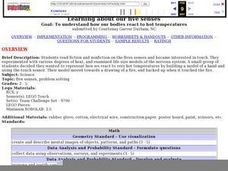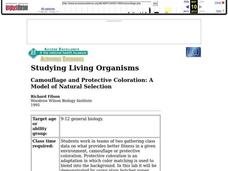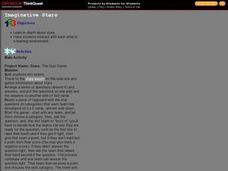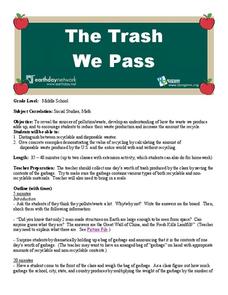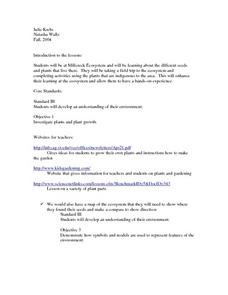Curated OER
The Common Tragedy of Consumerism
Pupils evaluate the effectiveness of current climate change solutions. In this global warming lesson, students look at the current measures implemented and analyze whether they are beneficial to the environment or not. Advance reading...
Curated OER
My Favorite Meal
Students investigate ecological systems and the multiple uses of the environment by studying the osprey population.
Curated OER
Life at the Pond
Students identify the bugs collected from the pond. In this biology instructional activity, students observe the living and nonliving organisms in the pond environment. They write a reflection about why nature is important and must be...
Curated OER
"Chips" Off the Old Block?
Students study using analogies between common items or occurrences and science concepts. They use the analogy of cookie recipes to that of the DNA "recipes" for living things to help us explain more about mutations.
Curated OER
Learning About Our Five Senses
Students study the sense of touch and various degrees of heat. They design a model that displays how the human hand reacts to heat using a touch sensor.
Curated OER
National Parks
Learners create national park brochures on selected endangered animals using research information, hand-drawn pictures, and the Pages and KeyNote software programs. This lesson was written for a TAG classroom.
Curated OER
Wacky Weed Parts
Students view picture of weed and identify roots, stems, flowers, leaves, and seeds, describe function of each different weed part, and discuss how different parts of weed work together to benefit plant in its new environment.
Curated OER
Camouflage and Protective Coloration: A Model of Natural Selection
Students collect data and compare whether protective coloration or camouflage provides better biological fitness in a given environment. They simulate predator prey interactions of two different species and use gene frequencies to...
Curated OER
This Stuff Makes Me Sick
Students participate in a lab showing the effects of pesticides on Lumbriculus variegatus. Several extensions and variations are also included in this lesson including one which relates the experiment to how pesticides enter our drinking...
Curated OER
Biological Control of Purple Loosestrife
Students examine the role of Purple Loosestrife in Illinois and Indiana rivers. In groups, they collect a wide variety of plants in a wetland and raise beetles in a controlled environment. They introduce the loosestrife into the...
Curated OER
The Quiz Game
Students are split into teams. Students travel to the stars lesson on a given web site and gather information about stars. Students then choose a category for the tag board that the teacher has made. The teacher asks a question and...
Curated OER
What Does Your "Homunculus" Look Like?
Students determine the density of touch receptors in various parts of the body on the right hand side. They use collected data to draw a picture of the
"homunculus" of an experimental subject.
Curated OER
Emerging Viruses
Students study the characteristics of living things and explore the characteristics of viruses including their structure, function, and reproductive cycles. They also explore the impact of viruses on human health by discussing common...
Curated OER
Solve the Mystery Photo
Pupils observe a mystery photo and use descriptive language to solve the mystery. In this descriptive language activity, students use scientific observation to figure out a mystery photo. Pupils rationalize their thoughts with...
Curated OER
Internet Research: Methane and Waste
Pupils conduct Internet research to discover the causes of methane and how to implement a waste action plan. They answer worksheet questions as they search Websites. On the Eduzone site students find information on reducing their own...
Curated OER
Conductors and Insulators
Students describe safe practices that are appropriate to a range of situations and environments. They discuss how electricity runs through wires that are insulated so that it cannot escape and determine that you can get electrocuted if...
Curated OER
The Trash We Pass
Students engage in a study of trash and how it is disposed of in the environment. They also research the impact of recycling and its effects upon the disposal amounts. Students calculate the advantages of recycling using real world...
Curated OER
Water Cycle
Third graders explore the water cycle and place pictures of the water cycle in sequential order. They investigate a problem and determine if it is reasonable or not to believe that there is water in air to cause a puddle. ...
Curated OER
Desert Adaptations
In this desert adaptations worksheet, students are given a water filled sponge which represents an animal. Students observe their "animal" for a 24 hour period and conserve the water in the sponge as best they can. They measure and...
Curated OER
Characteristics of Living Things
Student use the scientific method to experiment with worms. In this characteristics of living things lesson, students predict and examine the reactions of worms to dry and wet soil. Students share their findings.
Curated OER
Investigating Local Ecosystems
Students observe a local area for living organisms and their habitats. In this local ecosystems lesson, students complete an online field journal. Students share their findings and sort them into categories. Students visit a website to...
Curated OER
Predicting the Growth of Microorganisms
Students determine where microorganisms might be found around their school. In this scientific investigation lesson, students collect cultures from various locations and place these in petri dishes. They incubate the cultures to see if...
Curated OER
Food Chains
Fourth graders study food chains, producers, consumers, and decomposers. They play a food chain game and create food chain mobiles or posters. They take a nature hike around the school and observe various parts of a food chain.
Curated OER
Ecosystem Field Trip
Learners investigate the different seeds and plants that are part of the Millcreek ecosystem. They take a field trip to the ecosystem and complete activities using the plants that are indigenous to the area.






